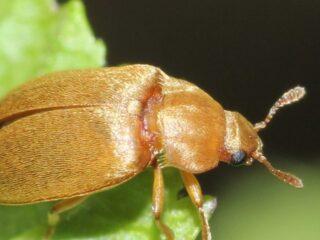Content
Tomato moth is a dangerous pest of tomatoes and other nightshades. It is a small butterfly of gray-brown color. It is nocturnal and hides in the leaves during the daytime. Can cause significant damage - up to 100% crop loss. The main treatment measures are treatment with chemicals and installation of pheromone traps.
Description of tomato moth with photo
The South American tomato moth tuta absoluta is a very small butterfly with a body length of no more than 7 mm. The color is gray-brown, there are two pairs of wings. If you look closely, you can see dark spots on the surface (they are visible only on the front wings).
The tomato moth produces small cylindrical eggs, not exceeding 0.4 mm in length. The color is creamy white, sometimes yellow. The larvae at the first stage are also cream-colored, up to 0.5 mm long. As it develops, it becomes yellow-green, with a black stripe appearing on the back of the head.
Once the tomato moth larva is fully mature, it turns greenish-pink.At the third and fourth stages of development, it increases significantly in size and reaches 4.5 and 7.5 mm, respectively. After this, it is covered with a cocoon approximately 8 mm long.

The tomato moth caterpillar feeds on green fruits and young tops.
Life cycle and reproduction
The life cycle of the tomato moth takes approximately 10 weeks at an average daily temperature of +15 degrees. If it is quite warm outside (about +25 °C), the cycle is shortened to three weeks. The pest is quite prolific, producing 10 to 12 generations per season. The main stages of development of the tomato moth are as follows:
- The imago is an adult individual, represented by a small butterfly that freely flies from plant to plant. Leads an active nocturnal lifestyle, and with the onset of daylight they begin to hide in the foliage of tomatoes and other plants.
- Females lay more than 200 eggs on the underside of leaves or on young shoots. The clutch is also found in the sepals of newly developing fruits, including green tomatoes.
- After 4-5 days, tomato moth larvae emerge from the eggs. They penetrate plant tissues and actively feed on juices.
- After 12-20 days, the larvae pupate directly in the mine or in the soil. Also, pupae can form on the leaf. During this time, the larvae go through all four stages of development and increase in size.
- The pupal stage of the tomato moth is short - from 6 to 10 days. The pest overwinters not only in the form of pupae, but also in the form of adults or eggs. Males live half as long - about 6-7 days, while females live from 10 to 15 days.
Signs of defeat
It is not always possible to see the tomato moth due to its small size. Butterflies mainly appear at night, and during the day they hide.Therefore, an invasion can be determined by a number of indirect signs:
- eaten leaves and stems;
- larvae and caterpillars inside tomatoes (green only);
- passages are noticeable on the surface of the fruit;
- bushes lag behind in development;
- complete death of the tops (advanced stage);
- Plants often suffer from fungal diseases; the above-ground parts rot and die.

A tomato fruit affected by a pest can be identified by visual inspection
What harm does
The tomato moth got its name due to the fact that it causes great damage to these particular plants. Farmers and gardeners note that crop losses due to severe infestations can amount to more than 50%, often up to 100%.
Insects feed on the leaves, destroying all mesophilic tissue and leaving only the epidermis (the superficial transparent layer). The main damage is mines in the form of characteristic spots. It is in them that the larvae leave their excrement. Gradually the affected area turns brown and dies.
In this case, the tomato moth larvae leave the mines and spread to other parts of the plant. They are able to penetrate quite deeply into young cuttings, as well as fruits. Accumulations of dark excrement are visually visible on the drilled holes. In this case, even slightly damaged fruits can only be thrown away. They are unsuitable not only for sale, but also for personal consumption.
How to get rid of tomato moth
There are different ways to destroy the tomato moth and prevent its invasion. Experienced gardeners recommend using drugs, traps and folk remedies. The most effective techniques are described below.
Chemical preparations for tomato moth
You can protect your plantings from tomato moths using special insecticides. This is the most effective way to fight. Even one treatment is enough to destroy the entire colony and provide a long-lasting protective effect for several weeks. Among the drugs that give quick results are the following:
- "Aktara";
- "Avant";
- "Fufanon";
- "Aktellik";
- “Let’s brand”;
- "Koragen";
- "Baciturin";
- "Ampligo";
- "Boverin grain-BL".

"Fufanon" is one of the proven insecticides that destroys the pest
All described products are used strictly according to the instructions. Treatment is carried out in the early morning or late evening, and the weather should be dry and windless. If there are not very many pests, one spraying per season is enough. In the future, you can use folk remedies.
Pheromone traps for tomato moths
You can also fight tomato moths using pheromone traps. Common devices are "TUA-Optima" and "Qlure-TUALD". The principle of operation is associated with attracting males with special pheromones. They stick to the work surface and die before they can fertilize the females. As a result, the tomato moth infestation is significantly reduced.
It is enough to place only 1-2 traps in the greenhouse. If tomatoes and other nightshades are grown in open beds, you can install 3-4 pieces. For industrial cultivation, 20-30 such traps will be placed on each hectare.
Biological method
You can also prevent the invasion of tomato leaf miner by biological means.It consists of attracting natural enemies of the pest. You need to do this:
- Purchase Trichogramma flies or Trichogramma parasites and tree bugs from a special store. These are predatory insects that actively destroy tomato moths - larvae, butterflies and eggs.
- Tits, sparrows and starlings are especially helpful in attracting birds. Feeders, drinking bowls, and birdhouses are created for them. But this method also has a downside - the birds eat berries and fruits, which will also reduce the yield.
Folk remedies for tomato moth
Folk remedies are also quite effective, especially in the early stages of development. They are especially useful in greenhouses since it is not advisable to spray insecticides in small spaces unless absolutely necessary.
Among the most effective folk remedies against tomato moths are the following:
- Mustard or rapeseed oil - coat the leaves on both sides with it. The method is quite labor-intensive, but effective and absolutely safe.
- The pest is afraid of the smell of any citrus fruit. Therefore, you can put peels of lemons, oranges and other fruits next to the plantings. Treating tomatoes with essential oil, which can be purchased at an affordable price, also helps.
- It is recommended to plant mint next to the beds, the smell of which repels many pests. If this is not possible, you can dry the mint bunches and place them between the rows.
- Another simple option is to remove the affected leaves and destroy them, and thoroughly douse the rest of the bushes with water to prevent the females from laying eggs. This can be done early in the morning or late in the evening so that the sun's rays do not burn the leaves.

Treating tomatoes with folk remedies helps stop the pest invasion
Prevention of occurrence
Preventing the appearance of tomato moth is much easier than dealing with the consequences of its life activity. To do this, experienced farmers and gardeners recommend carrying out the following activities:
- Every autumn, dig up the soil in the greenhouse and in the open ground. Larvae and adult insects of tomato moths overwinter in surface soil, so plowing will not give them a chance to survive.
- It is recommended to observe crop rotation and not grow nightshades (potatoes, tomatoes, peppers, eggplants) for more than 4-5 years in a row.
- Carefully remove the tops and burn them. It is not recommended to use plant residues for mulch or compost - tomato moths and other pests also overwinter in them.
- For prevention, it is better to grow varieties that are resistant to tomato moth. But even in this case, it will not be superfluous to periodically inspect the plantings and carry out treatments with insecticides or folk remedies.
- Disinfect greenhouses after harvesting. Particular attention should be paid to ceilings, connections of frame elements and other secluded places.
- Also, do not forget about periodically loosening and weeding the soil. To prevent the spread of pests, it is recommended to mulch the plantings with dry straw, hay or sawdust.
- Before planting, the seeds are pickled for 30 minutes in a 1% solution of potassium permanganate or any fungicide.
Conclusion
The tomato moth is dangerous not only because it eats tops and tomatoes. It can provoke fungal infections, which will lead to massive plant death. Therefore, at the first signs of invasion, plantings should be immediately treated with folk remedies. As a last resort, chemical insecticides can be used.









Yuri, do you ever know where these checkers you praise are sold?